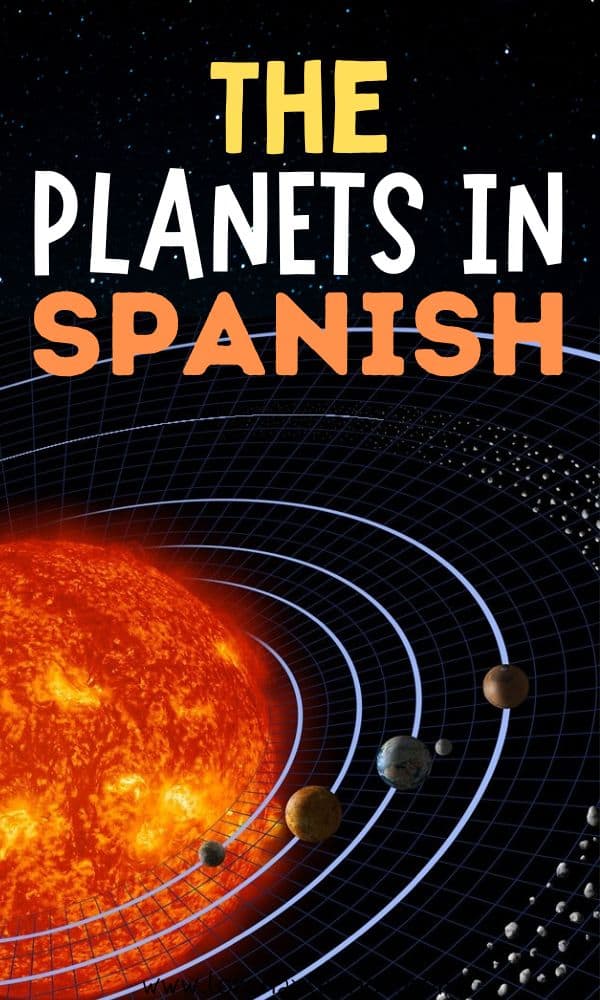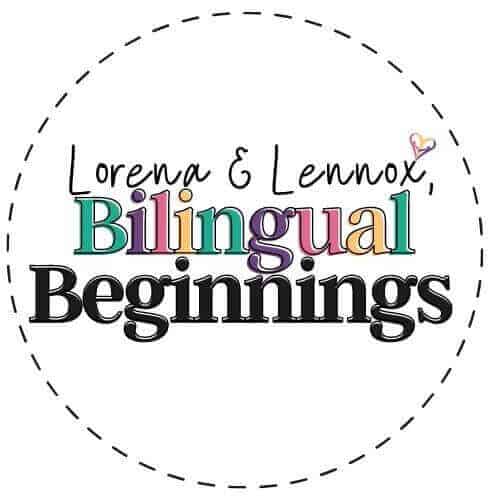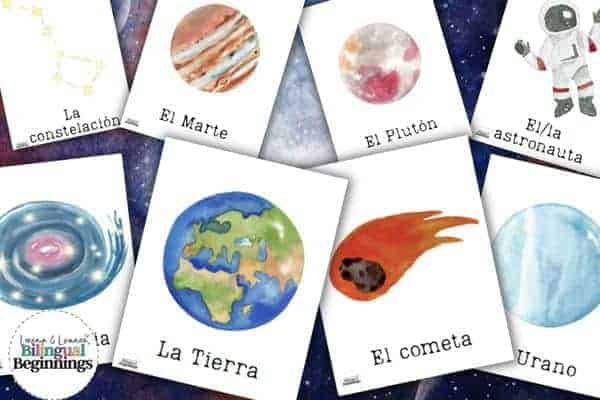Learning the names of the planets in Spanish is a fun and educational activity you can share with your kids. This post offers some easy to access information about the planets and solar system in Spanish and English.
We’ve also included fun activities and additional links to videos and informations so you can teach your children more about the planetas en espanol.
Happy learning and have fun looking up at the night sky!
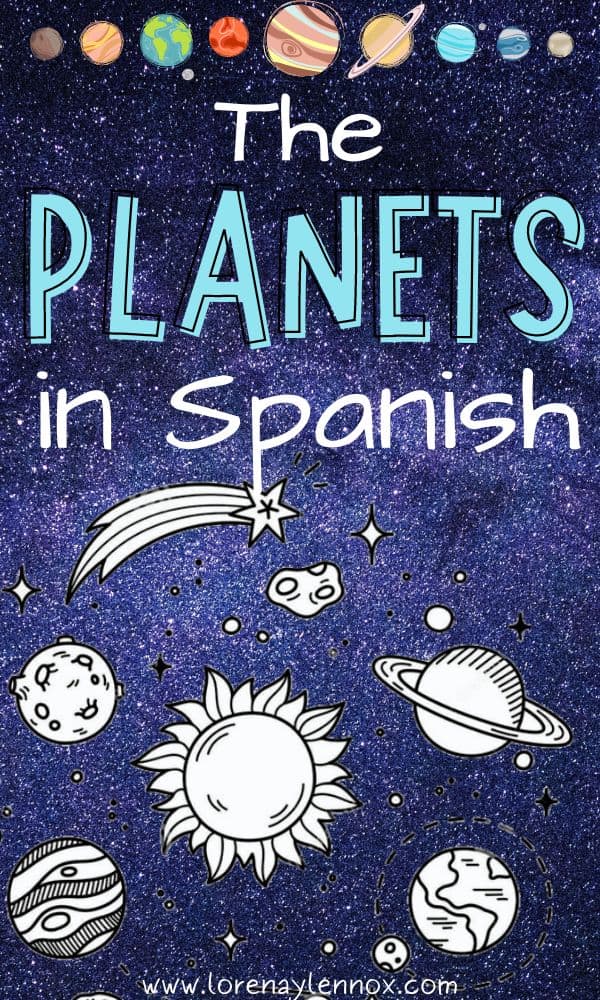
The Names of the Planets in Spanish
Did you know that the planets in our solar system are all named after the gods and goddesses of Roman mythology? Well almost all of the planets. Earth is the only planet not named after an ancient god. The ancient romans believed that gods controlled every aspect of life from the ocean to the sun.
For example, Mercury, or Mercurio, the planet closest to the sun was named after the messenger god. Mars, or marte, the red planet was named after the god of war. These planets along with Jupiter, Saturn and Venus were all named by the ancient Romans thousands of years ago. These are the only planets that can be seen without a telescope.
Did you know that the days of the week in Spanish are also names after the planets? Learn more here.
The largest planet in our solar system is Jupiter. The hottest planet is Venus, which also happens to be the closest planet to Earth. Saturn’s rings are almost entirely made out of water particles.
See if you can memorize the order of the planets according to their distance from the sun:
Mercury, Venus, Earth, Mars, Jupiter, Saturn, Uranus, and Neptune.
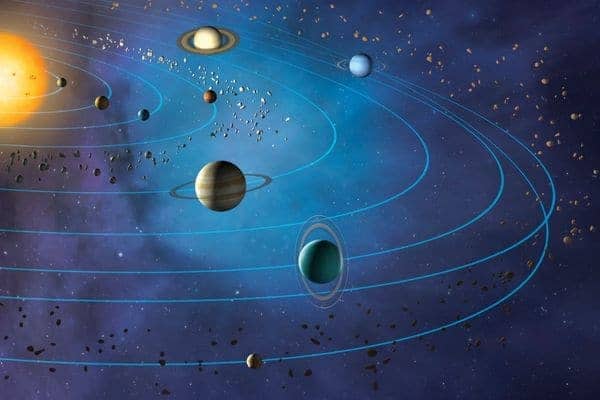
Follow below to see the names of all of the planets as well as the sun and the moon in our solar system in English and in Spanish. Can you remember them by order in English and Spanish? Try it out and see!
| English | Spanish | Pronunciation |
| Sun | El sol | (el – sol) |
| Moon | La luna | (la-loo-na) |
| Mercury | Mercúrio | (mer-cu-rio) |
| Venus | Venus | (beh-noos) |
| Earth | La tierra | (tyeh-rrah) |
| Mars | Marte | (mahr-te) |
| Jupiter | Júpiter | (hoo-pi-tehr) |
| Saturn | Saturno | (sah-toor-no) |
| Uranus | Urano | (oo-rah-no) |
| Neptune | Neptuno | (nep-too-no) |
Information about the planets in Spanish
Here is a fun fact: did you know there used to be nueve planetas (nine planets) in our sistema solar (solar system)? Pluto was once the smallest planet in our solar system but is no longer considered an actual planet due to its size. It is now considered a dwarf planet.
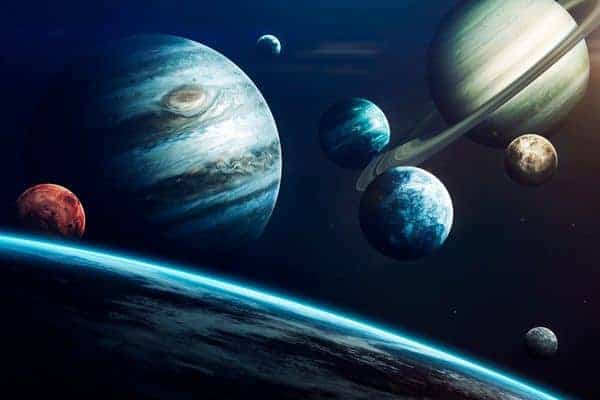
What’s a dwarf planet?
As the name suggests, the main difference between a regular planet and a dwarf planet is size. Pluto looks like a planet but did not meet the size requirement to be considered a full-fledged planet like Earth.
All of the planets in our solar system orbit around the sun. We are but a small part of a galaxy called the Milky Way. In Spanish, it’s known as la vía Láctea. It’s one of billions of galaxies that make up the vastness of the universe. The Milky Way can be observed by telescope or if you’re lucky enough to be somewhere far from light pollution even by the naked eye.
Here are some basic phrases to practice the names of the planets in Spanish:
El sol brillará mañana. | The sun will shine tomorrow.
La luna esta llena. | The moon is full.
La tierra es nuestro hogar. | Earth is our home.
El planeta Marte es rojo. | The planet Mars is red.
Júpiter es el planeta más grande de nuestro sistema solar. | Jupiter is the biggest planet in our solar system.
Neptuno es el planeta más alejado del sol. | Neptune is the planet furthest from the sun.
Venus es la diosa del amor y el planeta mas caliente. | Venus is the goddess of love and the hottest planet.
El sol es una estrella. | The sun is a star.
Los anillos de Saturno están hechos casi en su totalidad de partículas de agua. |Saturn’s rings are made almost entirely out of water particles.
Related: Free Printable Space and Planet Color By Number Pages in Spanish
Want to learn some new words about our solar system in Spanish? Here’s a list of words you can practice with your little ones.
English Spanish Pronunciation
| Stars | Estrellas | Es- tre–yas |
| Clouds | Nubes | noo-bes |
| Asteroids | Asteroides | as-tehr-roy-des |
| Comets | Cometas | coh-me-tas |
| Space | Espacio | es-pa-sio |
| Astronomy | astronomía | as-troh-no-mee-ya |
| Solar system | El sistema solar | Sis-teh-ma so-lar |
| Black hole | El agujero negro | Ah-gu-he-ro ne-gro |
| to orbit | orbitar | or-bee-tar |
Use these words in a sentence!
There are many stars in the sky. | Hay muchas estrellas en el cielo.
The sun is the largest star in our solar system. | El sol es la estrella mas grande en nuestro sistema solar.
The universe is gigantic. | El universo es gigantesco.

You can’t see the stars when there are too many clouds in the night sky. | No puedes ver las estrellas cuando hay muchas nubes en el cielo.
Astronomy is the study of outer space. | La astronomía es el estudio del espacio, el universo, y los objetos celestiales.
The planet must have been hit by an asteroid or comet. | El planeta debe haber sido golpeado por un asteroide o un cometa.
There are eight planets orbiting the sun. | Hay ocho planetas orbitando el sol.
We are a small part of a giant universe. | Somos una pequeña parte de un universo gigante.
Ways to teach children about the planets in Spanish
1. Through Space Picture Books
A great way to expose children to the planets and universe in Spanish is through reading picture books.
I have a list of 30 books about space in Spanish that you can browse through.
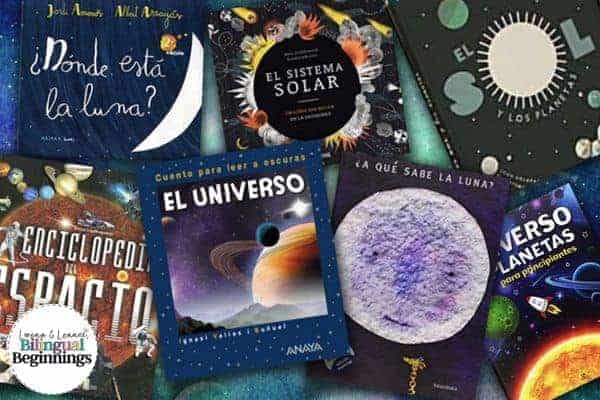
In our home, our favorite books is “El sol y los planetas.”
This is an interactive, pop-up book, perfect for older children, ages 7+.
It is jam-packed with information about the sun, moon, planet earth and surrounding planets. It has very nicely engineered pop-ups to show children the axis of the earth and the moon and how they revolve around each other.
I bought this book for my son when he was four years old and he absolutely loves it. I just paraphrase instead of reading all of the information in the book.
Find more books about the planets in Spanish.
2. YouTube Videos in Spanish about Space
Find some videos on YouTube and provide a small tidbit about the video. Include 2-3 videos.
The folks at Learning Time Fun have created this great short video that shows you the names of the planets in Spanish and how to pronounce them. It’s an easy and engaging way to practice.
Or sing-along to the Planet song! This video created by Basho and Friends not only goes over the names of planets in Spanish but many other related words. It’s an engaging way for your kids to learn and play.
Here’s another option for kiddos who love to sing-a-long!
Want to learn more about the Milky Way galaxy and our solar system? This video is entirely in Spanish but offers good graphics that provide excellent explanation.
3. Using planet flashcards in Spanish
Another great way to practice new Spanish words in through good old fashioned flashcards.
I have some planet and space flashcards in Spanish available in my Etsy shop for $1.97. Use these flashcards in a variety of ways to help your students memorize vocabulary and learn more about our solar system.
Learn more about how to use these space flashcards.
Conclusion
The stars and planets have been a source of inspiration for generations of people throughout the centuries. There is still so much to learn. Practicing some of these terms in Spanish is a great way to help your children with their language skills and inspire them to learn more about the Earth and the endless world above us.
Have fun looking at the stars! Disfruten mirando a las estrellas!
Additional Spanish Resources:
- Spanish Numbers 1-30: Free Printable Flashcards for Kids
- Learning Body Parts in Spanish: Vocabulary + Free Printable Worksheet & Flashcards for Kids
- 23 Transportation Vocabulary Flashcards in Spanish for Kids
- Learn the Spanish Alphabet With This ABC Bingo in Spanish
